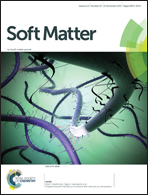Effects of length and hydrophilicity/hydrophobicity of diamines on self-assembly of diamine/SDS gemini-like surfactants†
Abstract
This work studied gemini-like surfactants formed from anionic surfactant sodium dodecyl sulfate (SDS) and cationic charged bola-type diamines with hydrophilic or hydrophobic spacers of different lengths using surface tension, small angle neutron scattering, isothermal titration microcalorimetry and cryogenic transmission electron microscopy. The critical micelle concentrations (CMC) and the surface tension at CMC (γCMC) for all the diamine/SDS mixtures are markedly lower than that of SDS. The shorter diamines reduce γCMC to a greater extent regardless of the hydrophilicity/hydrophobicity of the diamines. Meanwhile, either the hydrophobic diamine with a longer spacer or the hydrophilic diamine with a shorter spacer is more beneficial to decrease CMC and leads to the transition from spherical micelles into rodlike or wormlike micelles. This is principally because of the formation of gemini-like surfactants by the electrostatic binding between SDS and the diamines, where the electrostatic repulsion between the adjacent headgroups of SDS becomes much weaker due to the electrostatic binding of oppositely charged diamine with SDS, and the longer hydrophobic spacer may also bend into the hydrophobic domain of micelles to promote micellar growth. However, the hydrophilic spacers are more compatible with the headgroup region, leading to micelles with a larger curvature. This work contributes to the understanding of the relationship between the properties of constructed gemini-like surfactants and the natures of connecting molecules, and provides guidance to efficiently improve the performance of surfactants.



 Please wait while we load your content...
Please wait while we load your content...